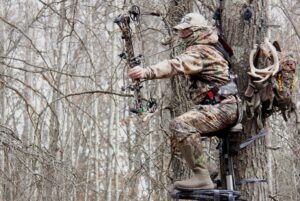Each has advantages and disadvantages. If you have been using one and never considered the other, this list of pros and cons may change your mind.
By Bernie Barringer
My buddy Paul was sitting across the table from me eating dinner with his face completely covered with several colors of paint: black, brown, olive and tan. Other guys at that table started poking fun at the odd sight and Paul looked a little sheepish as he realized he had forgotten to remove the paint before sitting down to dinner.
But Paul made a pretty good comeback with some interesting statements that ring true about the importance of hiding the glow of your face from game animals. He believes that your face is often the first thing they see, so making your face blend in is just as important that any other kind of camouflage.
It got me thinking about the use of paint and a face mask and how important it is when hunting. There’s no doubt that covering your face will reduce the chances that a deer will stop and stare right at you—one of the worst case scenarios in hunting—and help us stay better concealed. Some people are advocates of painting the face and others are just as adamant that a mask of some sort is better. Let’s examine the pros and cons of each.
Painting the Face
Putting on face paint is fast and easy. Taking it off? Not so much.
Hunting in warm weather can make a facemask very uncomfortable, but some paint on the face will not be noticed. Another advantage is that it moves when you move. When you turn your head, there’s no extra movement from cloth moving, and no chance that a mask will impede your vision if you have to turn your head quickly.
Paint comes in several colors and you can choose a couple that will be a good match for the terrain you are hunting. Sitting in the shade of a tree, you can choose darker colors. When stalking in sagebrush, go with the light greens and tan. When hiding out in the shadows of a ground blind, paint your face all black.
Unless you are naturally dark skinned, your hands often give away your location, especially if they are moving. One advantage of face paint over a mask is the ability to put some on the back of your hands while you are at it.
One of the drawbacks of face paint—an area where a fabric mask has an edge–is in the area of reflection. Face paint may darken your face, but if the sun hits you just right, it cannot stop the sun from reflecting off your face, and in many cases the shiny paint makes the reflection even worse. This is especially true if the paint has been faded or partially removed by sweat. When looking for face paint, make sure you find a brand that doesn’t go on shiny, but has a dull finish to it.
Wearing a Face Mask
The biggest advantage I see in using a facemask is the ability to pull it off and be done with it. Getting the paint off your face can be pretty involved and requires a mirror, something I do not have handy in most of my hunting.
Another advantage is that a mask covers your ears and face when it’s chilly. Often I don’t want a hat pulled down over my ears to impair hearing, but one piece of fabric is just about right to cheep the frost out. Same goes for the cheeks and chin.
Another advantage is protection from bugs. Mosquitoes can be a serious problem in the early deer season or during a spring bear hunt. The mask at least partially protects the little bloodsuckers from getting to your skin. Black flies love to get behind your ears and bite you there. A facemask prevents this.
Some of the drawbacks of using a facemask include the fact that they can impair your hearing. If you choose to use a facemask, choose one of a soft fabric that doesn’t make any noise when you move your head.
Facemasks can be hot when hunting in warm weather, and some people feel a little claustrophobic when wearing one. This is multiplied when sweat is running down your cheeks. If it’s hot with no breeze at all, a facemask will not be a good choice.
Make sure your facemask doesn’t block your peripheral vision. Choose one that fits tight to the sides of your temples and doesn’t stay in place when you turn your head. If you can turn your head inside the mask, your vision will be blocked.
Here’s the biggest negative of all for bowhunters: A facemask can affect your anchor point. Most of us anchor to the side of our face in some way. I use a kisser button on the corner of my mouth. The fabric will change your anchor point and possibly be distracting at the moment of truth. I usually pull my facemask down before drawing the bow but sometimes there just isn’t time.
Hopefully this comparison will help you make a decision about which of these two options is best for you based on the conditions you are faced with when you hunt. Using either one will increase your odds of being in the deer woods undetected. I would love to hear your comments below on which you prefer.
